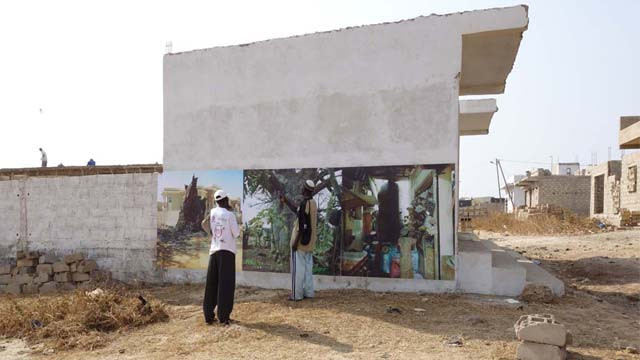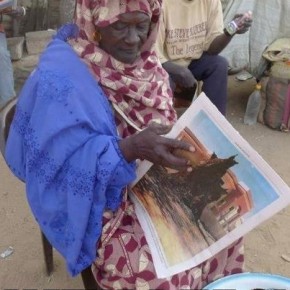
A photo installation in Ouakam // Urban Scénos 2013
VOIR Les photos
& un article dans Universes in Universe par Lucrezia Cippitelli sur les Scénos Urbaines Dakar, 2013.
« Autrefois ici, c’était une forêt dense et sombre ». C’est ce que dit un habitant de Ouakam, devant trois photos grand format de baobabs, collées sur un mur du nouveau quartier en construction, réalisé lors des Scénos Urbaines à Ouakam. Ce qui m’a été dit alors semble confirmer la justesse d’un regard à porter sur la disparition des baobabs. En décembre 2012, pendant un mois je vis à Dakar, à proximité de ce village traditionnel de pêcheurs Lébous aujourd’hui cerné et menacé par un processus galopant de gentrification dont la statue de la Renaissance africaine est l’élément le plus emblématique. Je découvre d’abord ces arbres, la force de leur présence, puis la manière ils sont organiquement intriqués dans les espaces et l’architecture du vieux village (Ouakam est originellement une forêt de baobabs), dans les cours, les jardins, les rues ; la manière dont les gens vivent autour, avec. La présence physique du temps qu’ils matérialisent renvoie à cette question du commun. J’explore. Un jour on m’emmène dans les quartiers en construction et je commence à entrevoir ce qu’il se passe. On en emblématise un, situé à proximité de la statue (le président Wade a posé devant et la photo a fait le tour du pays), les autres, on les coupe, on les brule, ils disparaissent. Mais, ce n’est pas si simple, on fait des rituels (des Ndeup) avant leur disparition tant leur charge magique est grande. En cela Ouakam s’inscrit dans une évolution des mégalopoles dans le monde et le devenir des baobabs un symptôme de la violence de ces mutations en cours. Ici, un processus de résistance face à cette gentrification est mené par les habitants du village traditionnel. La société civile réagit, mais ce processus est complexe, voire ambigu, car l’une des formes qu’il prend est de participer à l’évolution du quartier et d’en bénéficier. A Ouakam, mon travail sur les baobabs a suscité un réel intérêt de la part des jeunes artistes qui nous ont accompagné durant la résidence. Ils se sont mis à enquêter, m’ont indiqué la place des arbres qui ont disparu. J’ai découvert à quel point ils portent une présence imaginaire forte et à quel point leur disparition est pour beaucoup une blessure non exprimée.
– – – – – – – – – – – – – – – – – – – – – – – – – – – – – – – – – – – – – – – – – – – – – – – – –
« formerly here, it was a dense and dark forest », says a guy living in Ouakam, in front of the 3 large scale pictures of baobabs, glued on a wall in the area under construction next to the old village. This conversation, among others, confirmed the interest to question the fact baobabs disappear with this ongoing gentrification process. In 2012, I live in Ouakam for a month in dec 2012 – and come back in april 2014, next to the traditional Lebous fishermen’s village, surrounded and threatened by a massive gentrification process. The Statue de la Renaissance Africaine is the most emblematic of this process. I discover the baobabs, the force of their presence, and the way they are organically intricated in the spaces and architecture of the old village (Ouakam is originally a baobab forest), in the courtyards, gardens, streets; the way people live around, with. The physical presence of time they materialize relate to this question of the common. I explore. One day, a friend takes me in the under construction areas and I begin to understand: one tree, next to the statue, is emblematic, the others are burned, cutted. But this is not so simple: in order to cut them, people stage rituals (ndeups) as their magic charge is strong. Ouakam seems emblematic of the megalopolis over the world and what happens to the baobabs questions the violence of the ongoing mutations. Here the old village resist, the civil society reacts but the process is complex, even ambiguous, as Lebous also participate by sailing the land and get benefits of the process. The young artists and activists in Ouakam supported my focus on baobabs, in many ways. They indicated me the place of disappeared trees, took pictures, guided me… I discovered how much these trees carry on a strong imaginary presence, and how the fact they disappear hurts in secret a lot of people.
This installation, staged during Urban Scénos in Ouakam, is a series of 3 large scale pictures glued on a wall in the new area, which is also the place of the forest. The project is to make appear the ghost forest via a numerous number of these large pictures in the all new area, and when possible with pictures of the real trees before they were destroyed (I have some of them).
Une photo a été publiée en 4ème page du journal publié à la fin de la résidence [concept et graphisme par Bitcaves]. Le fait qu’il soit diffusé à 10 000 exemplaires a été un facteur important de relation avec les habitants lors du projet Scénos Urbains et un moyen d’afficher les questions.
– – – – – – – – – – – – – – – – – – – – – – – – – – – – – – – – – – – – – – – –
A picture was published on the 4th page of the newspaper published at the end of the residency [concept and graphic design by Bitcaves]. The fact 10000 copies were displayed was an important ellement in the relation with inhabitants during the Urban Scénos project and also a way to display ask questions.




